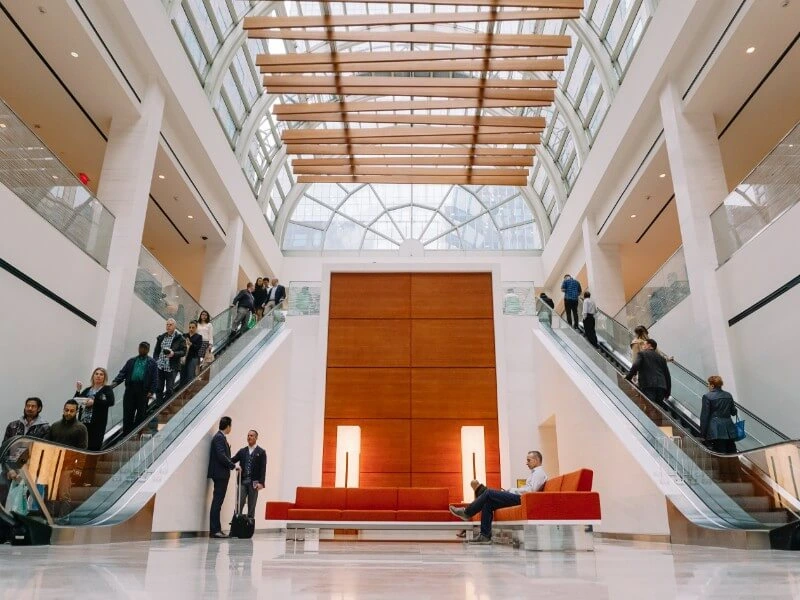5 ways to Boost Your Brand Uptime with Facilities Management

As you step into a bustling store, imagine being drawn in by the allure of a captivating brand. The atmosphere is electric, and you can feel the excitement in the air. You wander through the aisles, eagerly exploring the array of products that promise to enrich your life.
But, what if, instead of a vibrant and seamless experience, you encounter cracked shelves, disorganized displays, and indifferent staff? Your enthusiasm dwindles, and doubts about the brand’s commitment to quality creep in.
In business, this scenario vividly illustrates the importance of brand uptime in facilities—the ability of physical locations to uphold the brand’s promise and leave a lasting impression on customers.
The concept of brand uptime extends beyond virtual platforms and websites. It encompasses the tangible touchpoints where businesses and customers interact face-to-face, where the physical connection between brand and consumer is forged. While online presence is undeniably crucial in today’s digital age, the physical aspect of brand uptime can be a costly oversight. Our senses crave experiences that resonate with us.
Also read: Managing assets with facility software
To improve brand uptime, businesses must recognize the significance of a solid foundation. It begins by investing in reliable infrastructure that can withstand the test of time—well-maintained stores, warehouses, and production facilities that exude professionalism and reliability. Attention to detail and organized spaces to well-trained and attentive staff, becomes paramount in crafting memorable brand experiences. Furthermore, incorporating innovative technologies and design elements can elevate the ambiance and leave a lasting impression on customers.
In this blog post, we will explore the captivating world of facility brand uptime, exploring strategies and insights to enhance physical brand presence. By embracing the power of remarkable environments, businesses can forge deeper connections with their customers, foster loyalty, and carve a distinct niche in a world dominated by digital noise.
What is Brand Uptime?
Brand uptime in facilities refers to how consistently and reliably a facility delivers on its brand promise and maintains its desired performance and functionality. It encompasses all aspects of a facility that contribute to the overall brand experience, including the physical infrastructure, operational processes, and occupant satisfaction. Brand uptime reflects the facility’s ability to consistently meet its stakeholders’ expectations and demands.
Why is it important?
Brand uptime is paramount for facilities as it directly impacts their reputation, customer loyalty, and overall success. A facility’s brand is built on the promises it makes to its customers, whether it’s a retail store offering a seamless shopping experience or a data center guaranteeing uninterrupted connectivity. Any disruptions or failures in meeting these promises can significantly damage the brand’s image and reputation.
According to a survey by Salesforce, 94% of consumers say a brand’s treatment of its customers influences their decision to make a purchase. This emphasizes the importance of brand uptime which includes consistently delivering on brand promises, including providing uninterrupted service and minimizing downtime.
Furthermore, a study by Marq found that over two-thirds (68%) of businesses attribute revenue growth of 10% or more to brand consistency. By ensuring brand uptime, facilities can foster customer trust, attract more business, and ultimately drive revenue growth.
Maintaining brand uptime is a non-negotiable requirement in today’s highly competitive business landscape, where customer expectations are constantly rising. Facilities that consistently deliver on their brand promise build trust, attract more customers, and foster long-term loyalty. On the other hand, facilities that experience frequent downtime or fail to meet customer expectations risk losing market share, damaging their reputation, and incurring substantial financial losses.
The Role of Facility Management in Ensuring Brand Uptime
Facility management plays a pivotal role in ensuring brand uptime. Facility managers oversee and optimize all aspects of a facility’s operations, from maintenance and asset management to energy efficiency and emergency preparedness. They act as stewards of the facility, continuously monitoring its performance and implementing strategies to maximize its uptime and reliability.
Facility managers collaborate closely with various stakeholders, including maintenance technicians, contractors, and occupants, to create a conducive environment for maintaining brand uptime. They develop and execute proactive strategies, implement robust maintenance programs, and leverage advanced technologies to enhance the facility’s performance, minimize disruptions, and address challenges promptly.
Factors Affecting Facility Brand Uptime
Identifying Key Elements of Brand Uptime
Several key elements contribute to facility brand uptime. Firstly, the physical infrastructure must be designed and maintained to withstand the demands placed upon it. This includes ensuring the structural integrity of the building, the reliability of critical systems such as electrical and HVAC, and the efficiency of operational processes.
Secondly, facility management must prioritize proactive maintenance and asset management. Regular inspections, assessments, and preventive maintenance plans are crucial for identifying and addressing potential issues before they escalate into major disruptions. Lifecycle assessments and upgrades enable facility managers to optimize the performance and longevity of assets, reducing the risk of unexpected failures.
Thirdly, reliable power and energy management are vital for maintaining brand uptime. Installing backup power systems, optimizing energy efficiency measures, and implementing demand response programs can help mitigate the impact of power outages or fluctuations, ensuring uninterrupted operations.
Lastly, to ensure good brand uptime in facility management, you must focus on streamlining emergency preparedness and response. Developing robust emergency response plans, conducting regular drills and training, and utilizing technology for efficient communication during emergencies all contribute to minimizing downtime and ensuring occupant safety.
Common Challenges Impacting Facility Brand Uptime
While striving for brand uptime, facilities face several common challenges that can hinder their ability to deliver on their promises. Few of the key challenges impacting brand uptime in facilities include aging infrastructure, inadequate maintenance practices, limited visibility into asset performance, insufficient power and energy management strategies, and inadequate emergency preparedness.
Aging infrastructure poses a significant risk to brand uptime, as older systems are more prone to failures and inefficiencies. According to CDP survey, aging infrastructure has already had a noticeable impact on operations, with 87% of executives reporting its effects. In some cases, these problems have caused severe operational challenges that companies are still working to address successfully. This underscores the urgency of addressing aging infrastructure issues to maintain smooth operations and safeguard a brand’s reputation.
Additionally, the lack of comprehensive asset management systems poses a challenge for facilities in tracking asset performance and making data-driven decisions. Surprisingly, a publication from BI-Survey reveals that 58% of surveyed companies heavily rely on gut feel or experience for at least half of their regular business decisions, neglecting the power of data and information-driven approaches.
This reliance on subjective judgment can hinder their ability to effectively manage assets and make informed choices regarding repairs, replacements, and upgrades.
The last challenge is insufficient power and energy management that leave facilities vulnerable to power outages and energy inefficiencies, compromising brand uptime. Similarly, inadequate emergency preparedness and response measures can result in extended downtime during crisis situations, negatively impacting the facility’s reputation and stakeholder confidence.
Exploring the Relationship between Facility Management and Brand Uptime
Facility management and brand uptime are inherently interconnected. Effective facility management practices directly contribute to maintaining brand uptime by ensuring optimal facility performance, reducing downtime, and enhancing occupant satisfaction.
Facility managers leverage their expertise to proactively identify and address potential issues that could impact brand uptime. They implement preventive maintenance plans, conduct regular inspections, and create comprehensive maintenance schedules to ensure the facility operates at peak efficiency. Through efficient asset management practices, facility managers can extend the lifespan of critical assets, minimize failures, and optimize their performance.
Moreover, facility managers play a crucial role in optimizing power and energy management. By installing backup power systems, implementing energy-efficient measures, and participating in demand response programs, facility managers safeguard against power disruptions and mitigate energy-related risks.
Facility managers also lead the development of emergency response plans and coordinate regular drills and training sessions. By leveraging technology for emergency communication and implementing efficient response protocols, facility managers minimize downtime during emergency situations, ensuring a swift recovery and minimizing the impact on brand uptime.
In summary, effective facility management is instrumental in maintaining brand uptime. Through proactive strategies, asset optimization, reliable power management, and streamlined emergency preparedness, facility managers create an environment conducive to uninterrupted operations and superior occupant experiences.
Five Ways to Improve Brand Uptime through Facility Management
Proactive Maintenance Strategies
- Implementing Proactive Maintenance Plans:
- Conducting Regular Inspections and Assessments
- Creating Comprehensive Maintenance Schedules
One of the key ways facility managers can improve brand uptime is by implementing preventive maintenance plans. By leveraging reliable facility maintenance software, you can establish preventive maintenance plans that include regular inspections, equipment servicing, and calibration. By adopting a proactive approach, facility managers can identify and rectify minor faults early on, preventing them from escalating into major disruptions.
Regular inspections and assessments are essential for identifying potential vulnerabilities and areas requiring attention. Facility managers should establish a comprehensive inspection program, covering critical systems and components such as electrical infrastructure, HVAC systems, plumbing, and structural elements. These inspections help detect early warning signs of deterioration or malfunction, allowing facility managers to take prompt corrective actions.
Creating and adhering to comprehensive maintenance schedules is crucial for optimizing brand uptime. Facility managers should develop detailed schedules that outline routine maintenance tasks, including equipment servicing, filter replacements, and system calibration. By systematically addressing maintenance needs, facility managers can ensure the facility operates at peak performance and minimize the risk of unexpected failures.
Efficient Asset Management
- Implementing Asset Tracking Systems
- Conducting Life-cycle Assessments and Upgrades
- Implementing Predictive Analytics for Asset Performance
Efficient asset management is essential for improving brand uptime. Facility managers should implement asset tracking systems that provide real-time visibility into asset performance, maintenance history, and lifecycle data. By accurately tracking assets and their maintenance requirements, facility managers can schedule repairs and replacements proactively, minimizing the risk of unexpected failures.
Lifecycle assessments and upgrades are key to optimizing asset performance and minimizing downtime. Facility managers should conduct regular assessments to determine the remaining lifespan of critical assets and identify potential risks. Based on the assessment findings, managers can strategically plan and execute asset upgrades or replacements to ensure uninterrupted operations and enhanced reliability.
The utilization of predictive analytics can revolutionize asset management and improve brand uptime. By harnessing the power of data and advanced analytics, facility managers can gain insights into asset performance patterns, identify anomalies, and predict potential failures. This enables managers to take proactive measures, such as conducting targeted maintenance or repairs, before issues manifest and impact brand uptime.
Ensuring Reliable Power and Energy Management
- Installing Backup Power Systems
- Optimizing Energy Efficiency Measures
- Implementing Demand Response Programs
Reliable power supply is vital for maintaining brand uptime. Facility managers should consider installing backup power systems, such as generators or uninterruptible power supply (UPS) units, to provide seamless power during outages. These systems ensure critical operations continue uninterrupted, safeguarding brand reputation and minimizing customer dissatisfaction.
Efficient energy management not only reduces costs but also contributes to brand uptime. Facility managers should implement energy-efficient measures such as LED lighting, smart controls, and occupancy sensors to optimize energy consumption. By reducing energy waste, facilities can minimize the risk of power overloads, prevent system failures, and ensure uninterrupted operations.
Participating in demand response programs can further enhance brand uptime. These programs allow facilities to reduce their electricity consumption during peak demand periods when the strain on the power grid is high. By strategically managing energy usage, facility managers can avoid grid-related disruptions, maintain brand uptime, and potentially even benefit from cost savings.
Streamlining Emergency Preparedness and Response
- Developing Robust Emergency Response Plans
- Conducting Regular Drills and Training
- Leveraging Technology for Emergency Communication
Facility managers should develop comprehensive emergency response plans that outline clear protocols for various scenarios. These plans should include evacuation procedures, contact information for emergency services, and designated roles and responsibilities for facility staff. By establishing robust response plans, facility managers can minimize confusion during emergencies, ensure the safety of occupants, and reduce downtime.
Regular drills and training sessions are crucial for testing the effectiveness of emergency response plans and enhancing staff preparedness. Facility managers should schedule and conduct drills that simulate different emergency scenarios, ensuring that employees are familiar with evacuation routes, emergency equipment locations, and proper response protocols. Ongoing training helps employees respond swiftly and effectively during emergencies, minimizing the impact on brand uptime.
In today’s digital age, facility managers can leverage advanced technology for efficient emergency communication. This includes implementing mass notification systems, integrating emergency alerts into building management systems, and utilizing mobile applications for real-time updates and instructions during emergencies. By leveraging technology, facility managers can ensure effective communication, coordinate responses, and mitigate downtime.
Enhancing Occupant Comfort and Satisfaction
- Implementing Smart Building Solutions
- Monitoring Indoor Air Quality and Thermal Comfort
- Engaging Occupants in Facility Feedback and Surveys
Smart building solutions can significantly contribute to occupant comfort and satisfaction, ultimately impacting brand uptime. Facility managers should consider implementing technologies such as automated climate control, occupancy-based lighting, and personalized environmental settings. These solutions create a comfortable and tailored experience for occupants, enhancing their satisfaction and loyalty to the facility.
Maintaining high indoor air quality and thermal comfort is crucial for occupant well-being and productivity. Facility managers should regularly monitor air quality parameters, such as temperature, humidity, and CO2 levels, and take corrective actions when necessary. Ensuring optimal thermal comfort through effective HVAC management helps create a conducive environment that supports occupant satisfaction and enhances brand perception.
Facility managers should actively engage occupants by soliciting their feedback and conducting satisfaction surveys. This feedback provides valuable insights into occupant experiences, preferences, and areas for improvement. By incorporating occupant feedback into decision-making processes, facility managers can make targeted enhancements that positively impact brand uptime and occupant satisfaction.
Conclusion
Ensuring brand uptime is vital for facilities, as it has a direct impact on their reputation, customer loyalty, and overall success. By consistently delivering on their brand promise, facilities can build trust, attract more customers, and foster long-term loyalty. However, frequent downtime or failure to meet customer expectations can significantly damage the brand’s image and lead to financial losses.
To achieve brand uptime, facility managers play a crucial role. They can implement proactive maintenance strategies, efficient asset management practices, reliable power and energy management measures, streamlined emergency preparedness and response protocols, and occupant-focused enhancements. By embracing these responsibilities, facility managers can create an environment where brand uptime is optimized, stakeholders’ expectations are met, and the facility thrives in a competitive market.
Discover how FieldCirclecan help you prioritize proactive maintenance, efficient asset management, reliable power solutions, emergency preparedness, and occupant satisfaction to ensure uninterrupted brand uptime. Embrace these strategies into your store and keep your brand shining bright!


